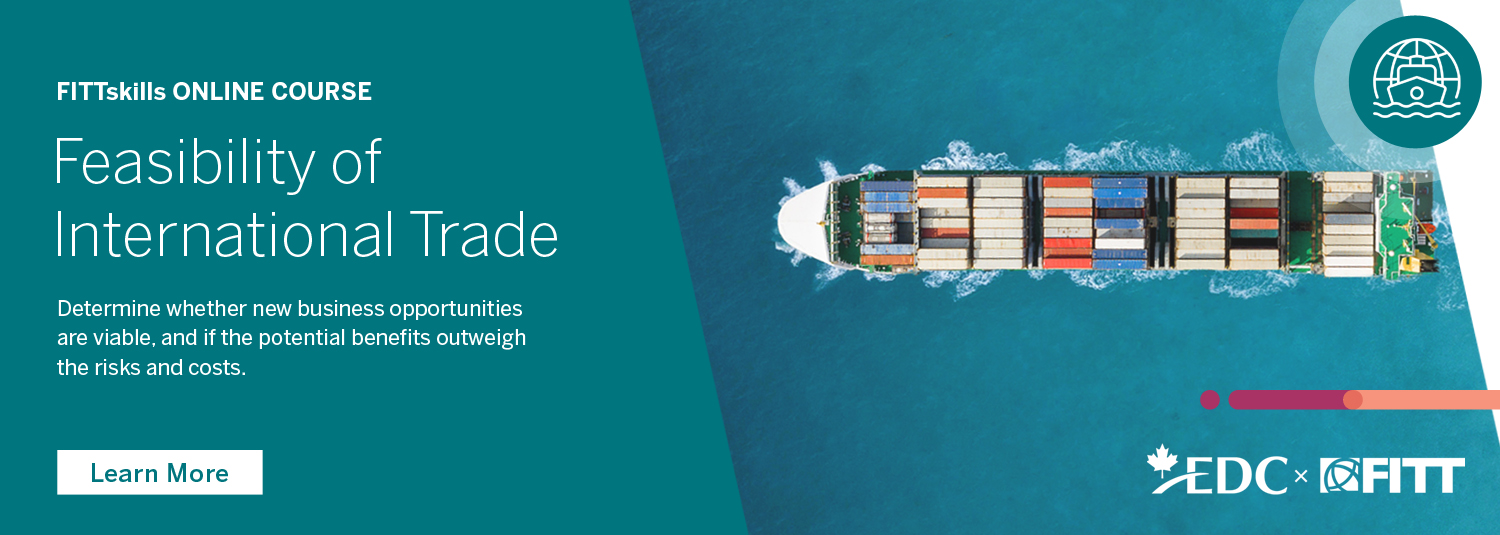
Whether undertaking a specific project or initiative, such as entering a new market or simply managing day-to-day operations, organizations have to be prepared for the possibility that things will not go as expected. Therefore, it’s crucial they learn how to manage risk.
Practitioners use risk management processes to help them anticipate problems and implement solutions. This is part of a continuous process of assessment, prioritization, and feedback. At any point in this process, the objectives of the organization or circumstances of the external environment may change, requiring an organization to be flexible in its approach to emerging risks.
Without a careful analysis of specific risks and a plan to mitigate them, organizations may suffer loss. Once involved in an international trade venture, organizations must protect their operations and their profitability through continual risk analysis and planning.
The biggest risk with any business venture is that the organization has no appreciation of risk or how it can affect them.
Risk management is vital to any organization. When developing a strategy to manage risk, develop one that can fall into one or more of the following categories.
1. Risk Avoidance Strategy
Organizations have the option to refrain from activities that carry unacceptable risks. For example, while looking to set up a subsidiary in a foreign location, an organization has been offered a site that was used by a chemical manufacturer. Since the environmental damage associated with the site is unknown and it doesn’t want to assume liability for clean-up, it may choose to pass up on the site, even if no other suitable property is available. On the other hand, a practitioner cannot use avoidance in all cases. Ceasing all business travel because of the risk of hijacking means essentially giving up on an opportunity to profit by doing business worldwide.
In short, risk avoidance is the elimination of risk by refusing to take a business-related action that puts your business at risk of incurring a loss. By failing to take the action, you prevent any possible risk from occurring.
Another perfect example of risk avoidance is with investment. If you’ve analyzed the possible risks associated with a certain investment and you believe the investment is too risky, your business strategist will advise you to drop the investment plans completely as one of the most effective risk management strategies.
However, this strategy should only apply in situations where the risk is likely to have a major effect on your business if it occurs. You shouldn’t always avoid risks that you encounter because sometimes you might miss out on a perfect investment opportunity.
You might drop an investment idea that could pay off because it seems too risky right now. This is why you should analyze every risk thoroughly using real-time data and advice from trading experts so that you can make an informed decision.
2. Risk Reduction Strategy
Risk can be addressed by finding methods to reduce either the severity of the loss or the likelihood of the loss occurring.
One way organizations respond to the risk of theft is by installing security systems. The challenge is to ensure that there is a correlation between the potential of losses from theft (what can be stolen and what is its value or impact?) and the cost and effectiveness of the security system (does it eliminate all risk of theft or only some?).
Another way of reducing risk is by adopting certain practices. For example, software development used to be extremely risky since it was only delivered in the final phase of development. Today, the process is to develop and deliver it incrementally to test performance before moving to the next phase.
Finally, organizations can reduce risk by outsourcing functions to those who are more skilled or to those who can demonstrate an ability to manage or reduce risks. The best example are international traders, who outsource much of their logistics to specialists. These specialists know the risks involved in international shipping and have the expertise required to reduce or eliminate them.
Basically, risk reduction involves taking important steps to make the risk less severe. These steps should be aimed at preventing the risk or minimizing its impact on your business. When it comes to choosing one of the most effective risk management strategies, risk reduction tops the list.
Still, for this strategy to be effective, you have to figure out practical measures that you need to put in place to make the possible risks in your business more manageable. Another example of risk reduction is when you implement a quality management system in your manufacturing company to ensure that your products are produced to the correct specifications.
If you’re in the finance industry, you’ll always face the risk of new industry regulations. You can reduce the impact of this risk by implementing digital solutions that you can use to manage regulations. This will help you to mitigate the risk involved in not complying with the regulations.
Want to learn more about how to mitigate possible risks by developing and implementing strategies and activities to monitor and manage them? Check out the FITTskills Feasibility of International Trade online course!
3. Risk Transfer Strategies
Risk transfer means getting another party to accept the risk, such as having a syndicate like Lloyd’s of London provide insurance for the venture. This is what happens when organizations take out any form of insurance: the insurer assumes the risk and the responsibility for restitution should losses occur.
Another way to transfer risk is through contracts. This often happens in construction projects and it’s one of the most common risk management techniques. The builder assumes any risks associated with faulty construction. Hedging strategies, futures contracts, and derivatives are other forms of transferring financial risks to others. Another option is to pool risks; a group may decide to spread risk among its members. If any one of them suffers a loss, they all contribute to restitution.
Although risk transfer doesn’t eliminate the risk completely, this risk strategy shifts the responsibility of the risk to another party. If you do international shipping or travel, you can transfer the risk of lost packages or suitcases to an insurance company.
This means that your company won’t accept responsibility for lost suitcases or products during shipping. You buy shipping or travel insurance coverage to bear the financial responsibilities for your company. If you run a factory or any other busy workplace, you can outsource some of your work together with the risks that accompany it.
4. Risk Retention
Organizations can choose to accept certain risks and any losses that may subsequently arise.
This is a viable approach to small risks where the cost of mitigation or insurance would be greater over time than the total losses sustained. The company will retain by default risks not avoided or transferred through a comprehensive risk management strategy. This includes risks so large or catastrophic they are uninsurable against or where premiums will be prohibitive.
War is an example of an uninsurable catastrophe, since most property and other commercial risks are not insured against war. This is why the terrorist uprising against British rule in Southeast Asia between 1948–1960 was called the Malayan Emergency; had it been called a war; the rubber plantation owners and tin mining industries wouldn’t have received any compensation from insurers for losses arising from the violence.
Also known as ‘risk acceptance,’ risk retention doesn’t reduce the effects of a risk or prevent the risk from occurring. Although this may not seem like a very sensible risk management strategy, it’s not a bad thing, because at times, the strategic cost of accepting the risk is lower than the cost of avoiding or mitigating it.
So, it’s more sensible to accept the risk. For instance, if a risk is likely to cost $20,000 and the cost of mitigating it is $200,000, it’s more financially prudent to accept the risk.
What Makes a Good Risk Management Strategy?
A good risk management strategy involves identifying, assessing, and mitigating risks that can affect your organization’s operations, finances, and reputation. A coherent and structured approach to risk management can help your organization make informed decisions, protect its assets, and maintain business continuity. Here’s an overview of the main elements of a risk management strategy, organized in a clear and easy-to-understand format:
1. Risk Process Identification
-
- Asset Inventory: List and categorize your organization’s critical assets, such as infrastructure, data, personnel, and intellectual property.
- Threat Identification: Identify potential threats to your assets, such as natural disasters, technological failures, human errors, and cyber attacks.
- Vulnerability Assessment: Evaluate the vulnerabilities and weaknesses in your organization’s processes, systems, and controls that could be exploited by threats.
2. Risk Types Assessment
-
- Risk Analysis: Assess the likelihood and impact of each identified risk, taking into account the organization’s vulnerabilities and the potential consequences of each threat.
- Risk Prioritization: Rank the risks based on their likelihood and impact, allowing your organization to focus on the most significant risks first
- Risk Analysis: Assess the likelihood and impact of each identified risk, taking into account the organization’s vulnerabilities and the potential consequences of each threat.
3. Risk Monitoring and Review
-
- Risk Monitoring: Continuously monitor the organization’s risk environment, including changes in threats, vulnerabilities, and the effectiveness of risk mitigation measures
- Risk Review: Regularly review and update the risk management strategy, incorporating new information, lessons learned, and best practices to ensure its continued effectiveness.
4. Communication and Reporting in Risk Management
-
- Risk Communication: Ensure that relevant stakeholders, including employees, management, and external partners, are aware of the organization’s risk management strategy, their roles and responsibilities, and the importance of risk management.
- Risk Reporting: Regularly report on the organization’s risk profile, the status of risk mitigation measures, and any incidents or issues that may arise.
Why Is A Risk Management Strategy Important?
Risk management strategies are crucial for organizations to ensure their long-term success, protect their assets, and maintain business continuity. A well-defined risk management strategy can help organizations identify, assess, and mitigate potential risks, allowing them to make informed decisions and respond effectively to adverse events.
1. Enhance Decision-Making
-
- Informed Decisions: Risk management strategies provide organizations with a systematic approach to identifying and assessing risks, which can lead to more informed decision-making.
- Risk Awareness: By understanding the potential risks and their impact, organizations can prioritize their resources and efforts to address the most significant threats.
- Informed Decisions: Risk management strategies provide organizations with a systematic approach to identifying and assessing risks, which can lead to more informed decision-making.
2. Risk Management Protects Assets and Reputation
-
- Asset Protection: Implementing risk management strategies helps organizations protect their critical assets, such as infrastructure, data, personnel, and intellectual property, from potential threats.
- Reputation Management: By proactively addressing risks, organizations can maintain their reputation and credibility with customers, partners, and other stakeholders.
- Asset Protection: Implementing risk management strategies helps organizations protect their critical assets, such as infrastructure, data, personnel, and intellectual property, from potential threats.
3. Risk Management Ensures Business Continuity
-
- Minimize Disruptions: A well-designed risk management strategy can help organizations minimize the impact of adverse events and maintain business continuity.
- Incident Response: Risk management strategies can guide organizations in developing effective incident response plans to handle crises, reducing potential damage and facilitating a faster recovery.
- Minimize Disruptions: A well-designed risk management strategy can help organizations minimize the impact of adverse events and maintain business continuity.
4. Improve Organizational Resilience Through Risk Management
-
- Proactive Approach: Risk management strategies promote a proactive approach to dealing with risks, allowing organizations to anticipate and adapt to changes in their risk environment.
- Continual Improvement: Regular monitoring, reviewing, and updating risk management strategies enables organizations to learn from past experiences and improve their risk management practices.
- Proactive Approach: Risk management strategies promote a proactive approach to dealing with risks, allowing organizations to anticipate and adapt to changes in their risk environment.
5. Enhance Stakeholder Confidence With Risk Reduction
-
- Trust Building: A comprehensive risk management strategy demonstrates to stakeholders that the organization is committed to identifying and addressing potential risks, building trust and confidence in the organization’s ability to manage adverse events.
- Regulatory Compliance: Implementing a risk management strategy can help organizations comply with regulatory requirements and industry standards, reducing the likelihood of penalties, fines, or other negative consequences.
- Trust Building: A comprehensive risk management strategy demonstrates to stakeholders that the organization is committed to identifying and addressing potential risks, building trust and confidence in the organization’s ability to manage adverse events.
6. Optimize Resource Allocation
-
- Prioritization: By identifying and prioritizing risks, organizations can allocate resources more effectively, focusing on areas with the highest potential impact.
- Cost Savings: Proactively addressing risks through a risk management strategy can lead to cost savings by preventing or minimizing losses and disruptions.
- Prioritization: By identifying and prioritizing risks, organizations can allocate resources more effectively, focusing on areas with the highest potential impact.
In summary, risk management strategies are essential for organizations to enhance decision-making, protect their assets and reputation, ensure business continuity, improve organizational resilience, enhance stakeholder confidence, and optimize resource allocation. A well-defined risk management strategy empowers organizations to navigate uncertainty and successfully manage your risk response.






disqus comments